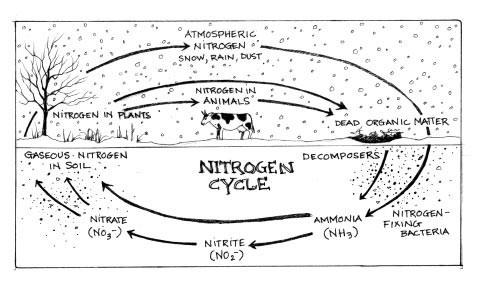
Nitrogen is both friend and foe. It is essential to the growth of plants and other organisms; that’s why so many people apply nitrogen to their gardens. Before the advent of synthetic fertilizer in the early 1900s, and before humans began extracting and burning fossil fuel, most trees, crops and other plants didn’t have enough nitrogen.
However, over the past 100 years or so, we’ve learned to convert previously unavailable nitrogen into fertilizer and energy. The result is that twice as much available nitrogen is being created now compared with a century ago. While this has been enormously beneficial to society for food and energy production, nitrogen now contributes to many of the environmental issues that worry us – acid rain, ground-level ozone, and over-fertilization of coastal waters.
Excess nitrogen is winding up in our lakes, rivers, and marine estuaries where it leads to eutrophication: excessive algal blooms, low oxygen levels, loss of important seagrasses, and the loss of fish and other organisms that can’t survive in these altered conditions.
Fifty percent of the nitrogen pollution in coastal waters, it turns out, comes from food. Or, more precisely, the way food is produced and distributed to feed the population of the region. Scientists studying the problem have examined data from the U. S. census and the U. S. Department of Agriculture to determine net food imports into the Northeast and the typical diet of area residents. They have also examined the efficiency of the human body in digesting food and the efficiency of septic and municipal wastewater disposal systems in removing nitrogen.
The major contributor to the local nitrogen problem is that the majority of the food we eat in the Northeast is imported from elsewhere. This amounts to an enormous transfer of nitrogen into the Northeast from the areas where the food was produced. This would not be a problem except that the human body is not one hundred percent efficient in its use of food. The nitrogen that our bodies end up not using is flushed into septic tanks or piped to wastewater treatment plants before being released into rivers, streams and coastal waters. The more nitrogen-rich our diet, the more nitrogen pollution we produce.
Functioning septic systems can remove most of the nitrogen in our waste. Most municipal systems, on the other hand, don’t have the capability of removing excess nitrogen. The technology exists, but implementation lags due to the expense, the perception that nitrogen doesn’t pollute, and lax regulatory standards for nitrogen discharge from treatment plants.
Meat and dairy production also contributes to the excess nitrogen problem. Meat consumption in the United States has doubled since 1960. Animals raised for meat, meanwhile, are increasingly spending their time not on pasture but in feedlots where food is brought in. Because feedlots generally do not grow their own feed, they typically do not have sufficient land available for disposing of nitrogen-rich animal waste. While feedlot agriculture is not common in the Northeast, the concentration of meat and dairy production on farms that are “too large” for their land base is increasingly common.
As a result, the manure is either applied to nearby fields at rates higher than what the land can use (leading to runoff), or is stored in lagoons (also leading to runoff). At the same time, the farmers producing the livestock feed elsewhere do not have access to the manure and must rely on synthetic nitrogen fertilizers – further increasing the amount of nitrogen that enters the environment. The result of this centralization of meat production is more nitrogen pollution, and the concentration of nitrogen where it is needed least.
You may have been wondering where the other fifty percent of the nitrogen pollution comes from. Among the largest sources in the Northeast are emissions from power plants and vehicles, whose nitrogen emissions eventually return to earth either in the air or with the rain. Excessive fertilization of suburban lawns and farm fields also contributes.
So what can we do? Well, you won’t find this kind of information in the scientific literature, but it certainly helps to drive efficient vehicles, maintain your septic systems, and support efforts to clean up municipal wastewater treatment facilities. Though New Englanders no longer produce more than a fraction of the food we eat, it is still helpful whenever possible to eat foods grown on small, local, integrated farms that are more efficient in their production and recycling of nitrogen.

